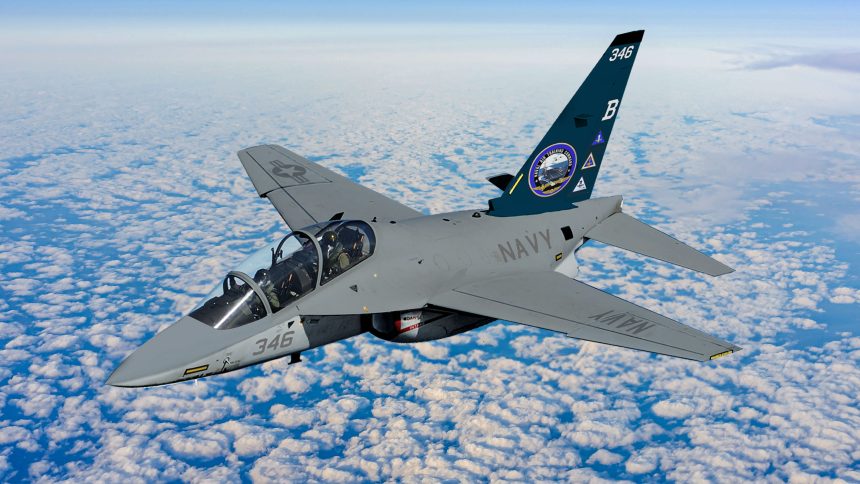By Robbin Laird
At the recent Sea-Air-Space Conference held in National Harbor, Maryland, Textron Aviation Defense was featuring its offering for the Navy’s Undergraduate Jet Training System. The Navy seeks to replace the aging T-45 Goshawk — with the candidates being the multi-engine Textron Aviation Defense-Leonardo-M-346N, the single-engine Boeing-Saab T-7 and the single-engine Lockheed Martin-KAI T-50.
I am familiar with all three aircraft, but really the focus from my point of view is upon the end-to-end training system. In all three cases, a “foreign” aircraft is being offered but the inclusion of the aircraft will be in an end-to-end training system.
When I came to the Textron booth, I had an advantage over many other visitors given my experience in working with the Italian Air Force and my familiarity with their training facility in Sardina, which the Textron offering leverages. In this sense, the M-346N is already a globally proven training system and the speed to Initial Operational Capability (IOC) is unparalleled in this competition.
As Lt. General Goretti, the Chief of Staff of the Italian Air Force, told me in his office in Rome in November 2924:
“The attitude of a modern air force is to look around, see the change in of the geopolitical situation, consider what you have in your inventory, and then try to think and reconsider the way of training to maximize your mission success. To follow this path, we saw the necessity of building a new kind of training facility.
“We decided upon working with our Italian company, Leonardo, to establish a new international flight training school. After only 16 months from concept to execution, we held our first class at the new training facility. We have more than 13 allied air forces already engaged in our program. This is a significant achievement which we have been able to do in only two years since the flight school opened in 2022.”
I want to underscore a key point, namely that 1 allied air forces are already engaged in the end-to-end training system. In total, 19 air forces are producing 4th and 5th generation fighter pilots in the M-346.
BGen Edi Turco, Chief of Staff of the Air Education Training Command / 3rd Air Region, and Head of the International Flight Training School (IFTS) Program Office, told me during the visit that the syllabus is modular so can be updated rapidly as threats change. He underscored that fifth-generation training was really about getting pilots of whatever aircraft being flown to understand the comprehensive and extended battlespace and to find their place within that battlespace. It is crucial to understand what platforms and payloads are available to deal with the threat envelope.
Textron Aviation Defense has partnered with Leonardo, which built and operates the facility. And Leonardo members were attending the Navy League event as well.
I spoke with Steve Helmer about the Textron Aviation Defense offering and approach. Helmer is an experienced Hornet and Super Hornet pilot in the U.S. Navy and is a 2014 graduate of the U.S. Naval Test Pilot School.
He noted that the U.S. Navy has decided not to take their initial student pilots to train off of the carrier deck. This has been aided by the advent of precision landing modes and standardization across the fleet of these modes. The focus is upon initial training in the simulator and leveraging advances in live virtual constructive training as well.
Helmer noted: “The Navy has signaled to us that they want to train junior aviators in the precision landing modes in the advanced jet trainer aircraft, as well as with carrier operational procedures using LVC training.”
He then highlighted the key point that Textron Aviation Defense, with its teaming with Leonardo and the existence of the Sardinia training facility, is able to leverage a proven end-to-end system — validated by more than 130,000 flight hours across the global fleet of 100 aircraft and more than 200,000 simulator hours across an installed base of 22 simulators — and adapt it for the U.S. Navy training solution.
The Italian M-346N will be the airplane used in the flying part of LVC training, but after initial Italian deliveries of the aircraft, the plane would be built in the United States.
In particular, Helmer stressed that the M-346N is a low risk, multi-engine, advanced ITS and a robust, ready now option for U.S. Naval Aviation Pilot and Naval Flight Officer/Weapons Systems Officer production.
The result according to Helmer: “We are able to start training pilots on a complete training system from day one.”
In other words, the LVC ecosystem is not an aftermarket add on, but it is built in from the outset.
And added to this is Textron Aviation Defense’s own long-standing work with the U.S. Navy.
As Helmer put it: “We have more than 70 years of in-house trainer experience just as Leonardo has more than 70 years of in-house trainer experience.
“There’s not a single naval aviator alive who has not flown one of our products, in training, if not beyond training.
“All of that DNA in-house and the pre-existing relationship with the Navy and the Marine Corps are really what enable us to be the U.S. provider for this aircraft.
“We will build it here in the U.S. and deliver it to the customer to their specifications.”
Featured imag: A rendering showing the M-346N (Image credit: Dylan Lumpkins/Textron Aviation Defense)


